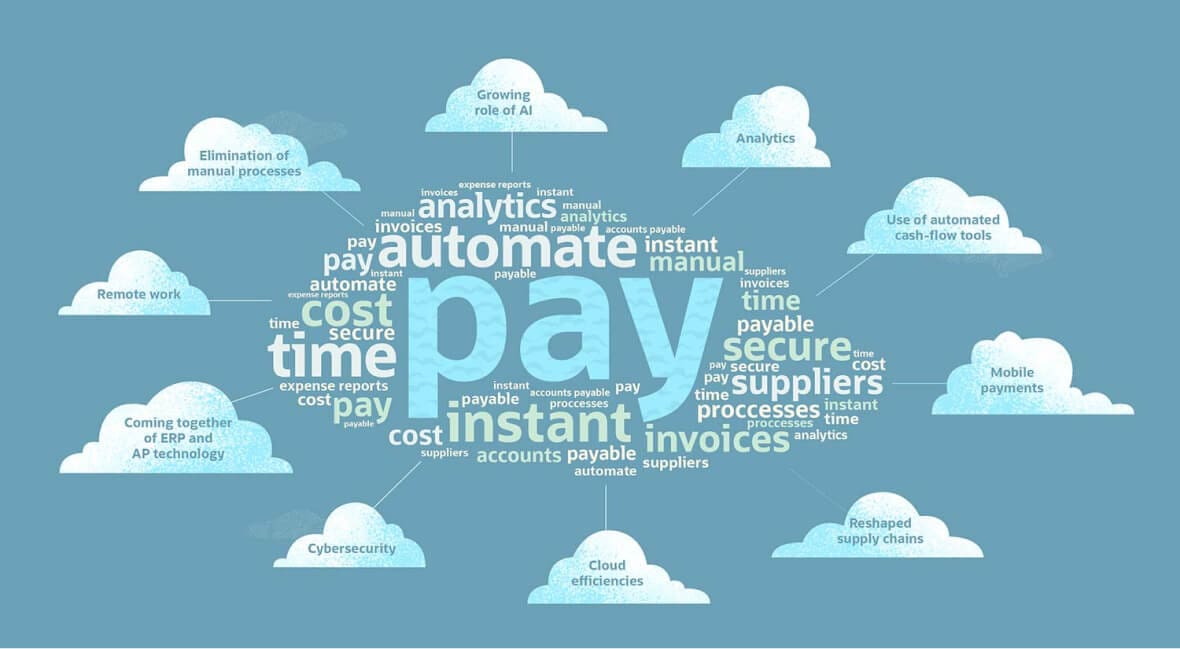Automation is coming to accounts payable (AP), a function that is still largely manual for many companies. While only 9% of AP departments are fully automated today, according to the Institute of Financial Operations & Leadership, that figure is expected to increase significantly in just a few years. Indeed, two-thirds of finance professionals expect their AP departments to be fully automated by 2025.
New technologies, such as artificial intelligence (AI), are enabling the automation of invoice processing and other core AP activities. These technologies can help AP departments reduce the amount of redundant, manual work and save companies time and money. But the move to automation is not just a matter of internal efficiency. In a world of remote work, scarce talent and supply shortages, automation that helps businesses spend less time processing vendor payments is also becoming a competitive necessity.
What Are AP Automation Trends?
AP automation trends are mostly developments that help AP departments to adopt faster and more efficient ways of handling invoices and processing payments to vendors and suppliers. Technological advances, including more powerful AI and machine learning (ML) software, as well as cloud platforms, are changing the AP game. In addition, at a time when talent is scarce and supply chains are overburdened, AP departments are facing increasing pressure from external partners, such as suppliers, services vendors and contract workers, to pay on time. Doing so makes for good relationships, and automation can assist.
Key Takeaways
- The pace of automation in AP departments will pick up markedly in the next few years.
- Artificial intelligence and machine learning will underpin many upcoming improvements, such as touchless payments.
- Technology will also have a role in helping AP departments more easily spot duplicate or fraudulent invoices.
- Automation in AP could alleviate some of the problems that have led to strained relationships with suppliers.
10 AP Automation Trends to Know
Accounts payable departments are tightening up their processes and using more sophisticated technologies not only to make payments, but to guard against fraud as well. The following 10 trends are shifting the way AP departments are processing and paying vendor bills.

1. Transition Away From Manual Processes
In the days when AP departments were still mostly paper-based — with vendors' invoices arriving in the mail and payment being made with printed checks — departmental processes were mostly manual. An AP staff member might type in the purchase orders, circle back with the department that initiated the purchase to verify that a product or service had been satisfactorily delivered, get the CFO or Controller to sign a check, and finally send out the check via the postal service.
These manual processes not only involved a lot of paperwork, but the communication related to payables also required a physical action — a knock on a manager's door, a phone call with a vendor or coworker to inquire about a confusing invoice, getting a check signed. At each step of these paper-based manual processes, companies saw the potential for (and reality of) errors, misplaced documents and late payments. Performing these tasks was also time-consuming, labor-intensive and extremely inefficient.
Today, many AP departments are using some level of automation to process invoices — such as optical character recognition (OCR) technology, which can convert an image or PDF into a machine-readable format, and business rules engines, software that helps execute company policies, such as routing invoices to the appropriate people within an organization for review and approval. In most cases, these processes are not fully automated. A recent survey by the Institute of Financial Operations & Leadership (IFOL) of its finance professional members found that the largest proportion of respondents, 54%, had "partially automated" AP departments, and relatively few, 9%, were fully automated.
Lack of automation is clearly creating issues for companies. Per IFOL, 22% of respondents cited delays caused by time spent processing invoice exceptions as their top AP processing challenge, while 21% said their workers were mired in too much manual data entry.
But change is coming. Two-thirds of IFOL respondents said their AP processes will be fully automated by 2025.
2. Remote Work Intensifies Automate AP Processes Pressure
For many companies, the pandemic led to a large-scale shift to remote work, and many employees now expect this to remain the norm. In addition, companies are increasingly tapping outside contractors, or gig workers, for hard-to-fill jobs or to complete certain projects. Both of these workplace trends may add to the volume and complexity of an AP department's work. AP departments that rely on outmoded manual processes — and multiple touches per received invoice or bill — may have a hard time supporting their companies' shifts to these new work models. In contrast, companies that make payments with less effort and oversight, through technology-supported processes that reduce the amount of tedious, manual tasks required of workers, are likely to have an advantage in competing for external talent.
3. AP Process Improvements Center Around AI
If companies still handed out employee-of-the-month awards, accompanied by cash prizes, the next few years would be very lucrative for their versions of Robby the Robot.
AI is becoming a core part of AP systems, reducing the need for manual, repetitive tasks like data entry, invoice routing and matching invoices to purchase orders. Another smart technology, ML, can easily categorize and search for documents and then extract needed data, particularly when combined with OCR technology.
Software can also be used to support AP processes through touchless payments. To understand how these work, consider a niche, 100-person publishing company that processes 1,000 invoices a year. If the AP department uses OCR and ML to extract the relevant data from digital invoices and has a system that enables largely automated approvals, the publisher can send payments without staff members having to manually take action on each invoice. Some invoices with especially large dollar amounts may still require careful review by the company's accountant or AP clerk, and payment streams would need to be audited periodically. Still, with most invoices running through an automated process, touchless payments would save AP departments time and money, ultimately allowing companies to process and pay vendor bills more easily.
4. ERP and AP Systems are Merging
Many businesses run their operations, including their accounting functions, using enterprise resource planning (ERP) systems. If the AP system isn't fully integrated with the company's ERP, data may need to be entered twice. Many companies are integrating their ERP and accounting software as an AP automation best practice, eliminating this inefficiency. And many are also finding that integration can improve other payable processes.
Procure-to-pay is a good example of the benefits companies can see from AP automation and AP-ERP systems integration. Take a hypothetical baked goods manufacturer, Brackish Bay Bakeries, which buys ingredients from multiple manufacturers and supplies products to high-end supermarkets in New England while also operating its own branded stores. Brackish Bay can't afford to get on their suppliers' bad sides, since it relies on them for flour, sugar, butter and more. The company needs its ingredients delivered promptly, the invoices it receives need to be matched against the relevant purchase orders and receiving documents, and payments must be made to suppliers in a timely manner, according to the contracted terms. If the bakery manufacturer's AP and core accounting system — often an ERP — are fully integrated, the company will have an easier time meeting all of those obligations and maintaining a solid relationship with its suppliers.
5. Value of AP Increases with Instant Reporting
An accounting department's AP records contain an enormous amount of information that could potentially be useful to the wider business. Analytics based on AP data — and produced through an automated process, versus a manual one — could help other departments identify areas that need attention. For instance, these analytics could help the accounting department anticipate an upcoming cash flow challenge, allow the procurement department to detect a price increase and switch to longer-term contracts, or highlight changes affecting travel and entertainment expense policies during an economic slowdown.
6. AI Takes Charge in AP Security
Because AP is the primary business department that disburses payments, it is a frequent target of attempted cyberattacks and other fraudulent activity. The AP database also contains plenty of sensitive payment information about the business's vendors and contract workers that need to be protected.
The dangers come from many directions: cybercriminals who pose as suppliers; real suppliers who send duplicate invoices or charge for services not actually provided with the hope that the AP department won't notice; internal staffers who set up fraudulent billing schemes using their own bank accounts. It's no wonder that businesses cited better controls and reducing fraud risk ranks as one of the top two reasons — along with speeding up payables — for AP departments to automate their processes, according to IFOL.
AI can look for patterns that suggest something isn't right with an invoice and flag the document for review. Another up-and-coming control technology that AP departments are starting to use: virtual credit cards, which are automatically generated in seconds and are optimized for secure transactions.
7. Cloud Technology Increases AP Efficiencies
Many businesses have already embraced cloud technology. A service provider typically manages the hardware and monitors the health of the systems, so many companies end up needing fewer in-house IT specialists, leading to a cost savings. Most cloud-based systems also provide mobile interfaces and dashboards that are accessible from virtually anywhere, adding convenience for those working on AP functions and allowing them to be more productive, including in remote environments.
8. Automated Payments Strengthen Supply-Chain Relationships
Once an arcane area that mainly procurement and manufacturing people talked about, the supply chain has become front-page news in recent years. That's what happens when your mother can't get toilet paper, your contractor can't finish your kitchen because the materials are stuck at a seaport, and you can't buy that bike you've been eyeing, no matter how much money you're willing to spend.
In addition to upsetting consumers, the widespread supply-chain disruptions of the past couple of years have also affected the B2B realm. When a business can't get important goods or materials, its own sales suffer.
The ongoing supply chain struggle is creating pressure within companies. When IFOL asked survey respondents about the core issues they faced as a result of delayed processes, 21% expressed concern about damaging their relationship with vendors and suppliers. That was the second most common answer, following 30% who cited stress created for the AP team.
Economists predict that the world's supply-chain problems will persist for at least several more months and possibly as long as two years. In the meantime, businesses with the most buying power often claim spots at the front of the line as manufacturing plants churn out products and cargo ships and truck fleets deliver those goods.
Smaller businesses can have a tough time competing. But they can narrow the gap in another way: by earning a reputation for paying on time. By consistently paying vendor bills, the business not only gets the attention of a supplier, but the supplier may even be willing to offer a discount with early-payment terms. These opportunities may give AP departments additional reasons to consider automated payments and to take advantage of the smart technologies that enable them.
9. Mobile Payments Add Convenience
Some suppliers may want to be paid via apps like Venmo or Google Pay. Taking advantage of a variety of payment mechanisms gives AP departments another way to solidify their reputations as fast, reliable payers.
10. Inflation Leads to Increase Automated Cash-Flow Management Tools Use
In early 2022, inflation in the U.S. had risen to a level that was four times higher than it was right before the pandemic. In other Western countries, including Belgium, Denmark, Finland, Italy and Spain, the spike in inflation since 2020 has been even worse.
Because AP departments control a sizeable portion of their organizations' cash outflows, they may be able to contribute to their companies' efforts to offset higher costs related to inflation. And if another supplier delivers goods that are not rising in price, a company that pays quickly might be able to capture an early-payment credit towards future purchases. These nuanced adjustments require sophisticated analytics. Adopting cash-flow management tools could save companies money, and particularly during difficult times, every dollar saved is important.
Take Advantage of Automation With NetSuite
Businesses that are automating their AP functions should begin by figuring out which of their AP processes would benefit most from automation. In addition, companies may want to evaluate their technology needs and consider making sure that an automated AP system is integrated with other core systems, including ERP, that companies use for their everyday operations.
NetSuite Accounts Payable can help automate many AP functions, such as the approval and payment of supplier invoices. It can also improve data accuracy by automatically matching invoices to vendor purchase orders. Using NetSuite Accounts Payable within the broader NetSuite ERP system would eliminate the need for double-entering information and allow other departments in the organization to take advantage of potentially valuable AP data and analytical insights.
Most finance professionals expect their AP functions to be fully automated by 2025. The changes that will result — including automatic invoice recording and touchless payments — are bound to make companies' AP departments more efficient and the businesses themselves more competitive. Some of the underlying technologies will also protect AP departments from fraud, eliminating the need for the laborious physical checks of the past.
#1 Cloud
Accounting Software
AP Automation Trends FAQs
Will accounts payable be automated?
The AP function was once largely manual and is already moving toward being at least partially automated at many companies. The pace of automation has been picking up. In a survey by the Institute of Financial Operations and Leadership, two-thirds of finance professionals said they expect their AP departments to be fully automated by 2025.
What is the future of accounts payable?
Optical character recognition (OCR) and business rules engines will allow AP departments to greatly reduce the amount of manual work staff members need to complete. The decrease in rote tasks may allow AP teams to focus on higher-value activities, such as investigating anomalies.
What are the benefits of accounts payable automation?
Internal efficiency is a huge benefit, as the cost and time required to process bills and invoices drops significantly with automation. In addition, automation reduces the risk of errors and payment delays, allowing companies to forge better relationships with suppliers while also protecting themselves against potential fraud.
What are the challenges faced by accounts payable?
Mistakes and lost or miscoded documents are among the biggest problems AP departments face because of the high volume of work they handle and their reliance on manual processes. Managers in these departments also have to guard against fraud, which can come in many forms, including fake invoices sent from the outside.
Does NetSuite have OCR?
Yes, with NetSuite bill capture, invoices received as images or in PDF format can be imported via drag and drop. NetSuite's system can do an automatic OCR scan to identify the important information and create a record, minimizing the need for manual data entry.
What does high payable days mean?
Days payable outstanding (DPO) is a measure of the average time needed for a company to pay its contractors and suppliers. A high DPO ratio means that it takes a company more time to pay its bills and creditors.
How is digital AP changing the landscape?
Digital AP is a move away from many processes that require paper, including old-school "wet signatures" with actual pens. It is part of a larger AP automation trend that is reducing manual, repetitive work within AP departments.









